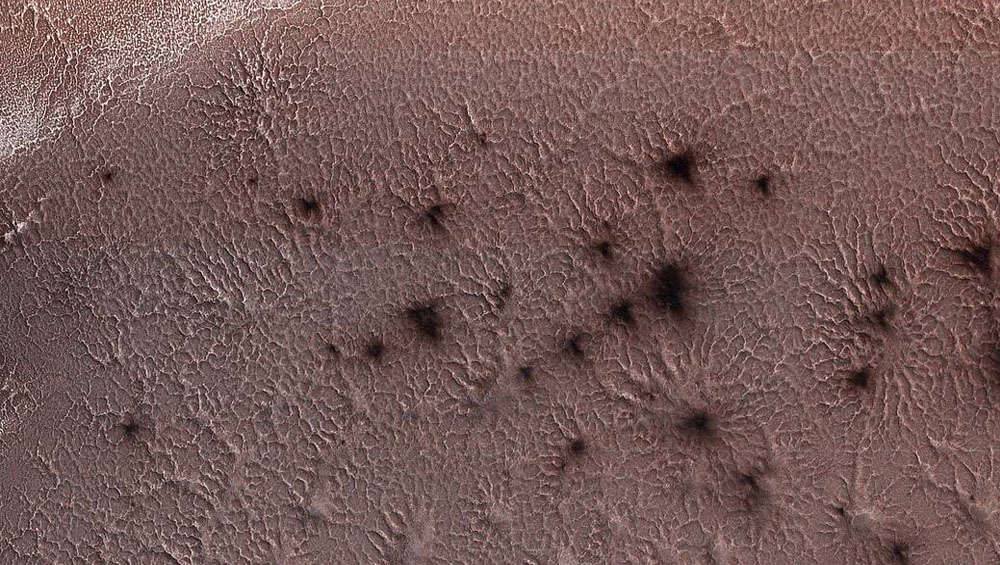Create a free profile to get unlimited access to exclusive videos, sweepstakes, and more!
David Bowie’s 'spiders from Mars' are not alien arachnids, but still out of this world

In his iconic single Ziggy Stardust, David Bowie sings about the “spiders from Mars” as Ziggy plays guitar — and he isn’t entirely wrong.
What appear to be huge eight-legged life-forms crawling around on the Red Planet are actually geological formations known as araneiforms. Though they share a name with Bowie’s backup band from the early ‘70s, these spiders from Mars are now the first physical evidence of frozen carbon dioxide sublimating (going straight from a solid to vapor state) on the Red Planet. Araneiforms were thought to be the result of sublimation before, but now that sublimating CO2 has formed spider legs under Martian conditions in a lab, we know how they spawn.
“We have provided strong evidence that such a process can generate dendritic spider patterns,” researcher Lauren McKeown, who recently led a study published in Scientific Reports, told SYFY WIRE. “Our work has shown for the first time that sublimating CO2 ice can form spider-like patterns, and until now, this process has only been framed in a theoretical context; nobody has physically observed it.”
There is nowhere on Earth araneiforms can be found. They emerge every spring on Mars as dry ice sublimates and have been imaged by satellites such as the Mars Reconnaissance Orbiter, but there was never much evidence for how they formed. Hypothetically, it was thought that when rays of sunlight reach through the translucent ice and touch the regolith below, it warms up, building up pressure. That pressure would supposedly cause the ice to crack. Vaporized CO2 would start to escape, leaving behind the eerie spider legs.
McKeown and her team created Martian conditions for the spiders to form in at the Open University Mars Simulation Chamber. They wanted to see whether the processes proposed in the theory, known as Kieffer’s hypothesis, would actually result in creepy-crawly formations. Blocks of CO2 ice had holes drilled into them and were suspended above different types of gravel that went from fine to coarse. The pressure inside a vacuum chamber was lowered to simulate Martian atmospheric pressure before the ice blocks were lowered to the surface. Right away, the blocks started to vaporize, and a plume of gaseous carbon dioxide emerged.
“On Mars, the ice will likely crack at regions of perceived "weakness", i.e. where pre-existing araneiforms lie, or where there is undulating topography or slopes,” McKeown said. “Gas will then rush to this vent, eroding the surface through conduits.”
The spidery patterns of araneiforms are believed to be the result of gas moving from a high-pressure area to somewhere with lower pressure. The reason CO2 ice won’t just leave behind flat land when it sublimates is that ice and regolith on Mars are uneven, just like many topographical features on Earth, so any processes that change them are not going to affect an entire region of Martian crust in the exact same way. Carbon dioxide moves around in conduits, or channels, once it has reached its gaseous state. That can explain the multiple “arms” and “legs” that make it look as if a tarantula left its imprint there.
Something that surprised the research team was that the dry ice blocks sublimated much faster, and scattered material everywhere, when they were allowed to vaporize directly on the gravel. This happened because much more frozen CO2 was exposed to comparatively warm sand in a short timespan instead of being gradually lowered. Turbulence arose in the gaseous CO2 as it morphed from its solid state, and that was what made such a mess. McKeown believes that observing this behavior in a lab on Earth could actually give more insight into about how similar things actually occur on Mars.
“Measurements of how far material was ejected when we dropped the block into the gravel can be used to infer how far material might be ejected by a sliding CO2 block down linear gully channels, and may infer whether darker sediment is ejected from within the channels,” she said. “We hope to model this further to better understand the behavior of this phase change under the cooler conditions on Mars.”
Whether or not there is any life on Mars (another Bowie reference), the spiders from Mars are infinitely cool.



























